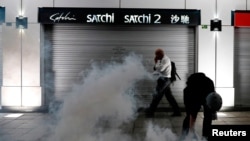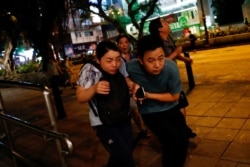It didn’t seem to matter that police barred several protest marches Saturday, citing the fear of violence. Thousands of residents, furious with government indifference and harsh policing, fought battles throughout the city as they tried frenzied, urban guerrilla tactics to block roads, occupy the airport terminal, march en masse, participants shrugging off rounds of tear gas.
Protesters staged the flash protests in lieu of organized, legal marches after police took the highly unusual step of denying permits, saying they would invite violence. Instead, groups of several hundred protesters gathered in the Kowloon neighborhoods of Tai Po and Tai Wai before hitting the tourist center of Tsim Sha Tsui.
For many hours people staged a sit-in at the airport, the second since Friday, to attract international attention to their cause. In addition, strikers blocked the Cross Harbour Tunnel briefly before darting away.
Some lit a fire outside the police station in Tsim Sha Tsui. Others hurled taunts and rocks, and shone laser pointers at officers’ faces until squads of riot police pushed forward, dousing the crowd with tear gas. Soon after, the protesters dispersed and moved on to their next target.
Police released a statement, condemning the “violent acts.”
Protesters, however, said they would continue with such provocative actions, because it was proving effective in rattling the government and wining the support of Hong Kong residents.
“Even if the government won’t let us legally protest, we’ll come out,” said Jack, a 25-year-old auditor standing near the front line in Tai Po. “For us, it’s like, ‘live free or die.’ We don’t want to live in a world like China now.”
Three months of protest
Now in their third month, mass protests started in June, when government critics demanded that the city withdraw an amended bill that would allow the government to ship criminal suspects elsewhere for trial, including mainland China.
Residents — more than 2 million marched in June — said the bill would open the door to specious accusations against dissidents, religious figures, businessmen and others who actively oppose China’s Communist Party.
Under pressure from millions of residents, Carrie Lam, the city’s chief executive, agreed to shelve, but not kill, the bill. Hong Kong officials have refused to concede to any demands made by the protesters, including the creation of an independent commission into police actions against protesters and the full withdrawal of the controversial extradition plan.
Young people have staged increasingly risky and provocative actions to get the government to respond. As a result, their decisions to besiege police stations, square off with police and even set fires, has resulted in quicker and harsher police response, as well as hundreds of arrests.
As a result, fewer people are now protesting. About 1,000 protesters flocked to or near the front line in Tai Po Saturday, a substantial drop from earlier weekends. Several protesters said they were sitting out of Saturday’s actions, resting up for Sunday, which has often been a long day of confrontations.
How will this end?
Even some supporters are worried the young people can’t continue either the pace or the frequency of protests.
“What’s the way out? I’m also thinking of that,” said Alvin Yeung, a lawmaker who visited the scene and spoke with protesters. “There is no solution to this mess.”
Yeung said he urged a young protester to consider fall elections, which could reduce the power of the pro-Beijing bloc in the legislature. He realized, though, that young people may not find hope in that.
Tom Lee, a 23-year-old protester near the front line, admitted he is worried about the mass arrests, such as those July 28, when 44 people were charged with riot, a crime that carries a possible 10-year prison term.
“I have no choice,” said Lee, wearing a white construction helmet. He scouted the riot police standing more than 100 yards away. “If no one stands out here, there will be no one to speak out.”












